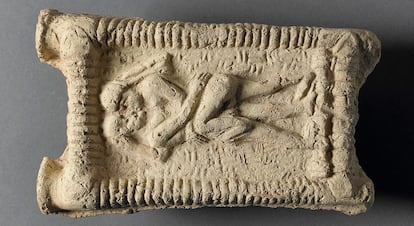The first kisses were recorded in Mesopotamia 4,500 years ago
Sumerian and Acadian texts recover the practice as both a show of affection between friends and family and as part of sex

No one knows when humans started kissing each other. But the first written references to kissing appear in Mesopotamia 4,500 years ago. At that time, kisses had the same functions as today: as part of sex, as a show of affection or respect and even as a religious or superstitious gesture. They had, however, lost what some anthropologists believe to be their original function: finding the ideal partner via the chemical signals exchanged in a kiss.
In her book The Science of Kissing, researcher Sheril Kirshenbaum reviews the work of anthropologists who place the first mentions of the kiss in the origins of Indian civilization 3,500 years ago. From there, Alexander the Great’s men had taken the practice to Ancient Greece. These early references in Hindu sacred texts, such as the Atharvaveda, did not have a specific word for the act of kissing. Parts of the work use the expression “smell with the lips.” Another line of the poem can be translated as “a young man of the house licks the young woman repeatedly.” Here, Kirshenbaum writes, “licking can refer to a type of kiss or caress.” Another Hindu poem, the Mahabharata, mentions the act of joining the lips. But this text, like the Vatsyayana Kamasutra, is much more recent.
In an article published in Science, two Danish researchers maintain that the first explicit references to the kiss appear in texts from Sumer, a civilization that emerged in the south of present-day Iraq. One of the authors is Troels Pank Arbøll, a professor at the University of Copenhagen and an expert in ancient civilizations of the Middle East.
“The first textual evidence that mentions romantic-sexual kisses seem to come from ancient Mesopotamia around the year 2500 before Christ,” Arbøll writes in an email. Writing was invented in this part of the world, between the Tigris and Euphrates rivers, some 5,200 years ago, with Acadian and Sumerian texts on clay tablets. “It was cuneiform writing, used until 80 years after Christ. We have many sources available today from that period. However, when it was invented, writing in ancient Iraq was used mainly for administration, which means that other kinds of texts only appear gradually,” he adds. We would have to wait 700 years for texts about kissing.
“The first references to kisses occur in mythological narratives about the behavior and actions of the gods. Only a little later (especially at the beginning of the second millennium A.C.) do we find clear references to kisses in private documents,” the Danish scientists says. The first mention of the kiss appears in the so-called Barton cylinder, a mythological text written in Sumerian between 4,350 and 4,500 years ago. As Arbøll says, in column 1, line to 14, and column 2, lines 4 to 10, the following paragraph appears:
“Those days were indeed faraway days. Those nights were indeed faraway nights. Those years were indeed faraway years. The storm roared, the lightning flashed. In the sacred area of the city of Nippur, the storm roared, the lightning flashed. Heaven talked with Earth, Earth talked with Heaven. With the goddess ‘Great-Good-Woman-of-Heaven,’ the older sister of the god Enlil, with Ninhursag, with the ‘Great-Good-Woman-of-Heaven,’ the older sister of Enlil, with Ninhursag, had intercourse. He kissed her. The semen of seven twins he planted in her womb.”
The text is from a millennia before the Hindu sacred poems about joining lips. Later tablets include mentions of all kinds of kisses imaginable. Sumerian texts speak of kissing as the act after sex. Meanwhile, some Acadian tablets, from the civilization north of Sumerian, mention kissing the feet or the ground walked upon as a show of respect or submission to parents or priests, while others mention kisses as a manifestation of sexual desire. Arbøll clarifies that the former kisses were not practiced in this part of the world: “We do not maintain that the kiss originated in ancient Mesopotamia, but quite the opposite.” With the Barton cylinder, the Hindu texts and other, more ambiguous references from Egypt, the Danish scientist maintain that “that form of kissing was practiced over a large geographic area in antiquity, which we argue does not point to a single point of origin, at least in historical times; rather, it seems to have several different origins.” But if anyone insisted on identifying a single origin, Arbøll adds, “they would have to look in prehistoric times.”
And quite prehistoric. Sophiie Lund Rasmussen, a University of Oxford biologist and co-author of the Science study, says that the species closest to humans also kiss each other. “Studies in bonobos and chimpanzees have demonstrated that both species kiss each other, which can suggest that the practice of kissing is a fundamental behavior in humans, which explains why it can be found in all cultures.” And why would it be fundamental? “Evolutionary anthropologists have suggested that romantic-sexual kissing evolved with the purpose of evaluating aspects of a possible partner through chemical signals communicated through the saliva or breath; to mediate feelings of attachment and closeness; and to facilitate sexual excitement,” Rasmussen says in an email. “That sexually romantic kisses are also seen in our closest living relatives suggests that this behavior is much older than our most ancient documentation,” she adds. Humans and large simians diverged five million years ago.
Kirshenbaum, the author of The Science of Kissing, which is not related to the Science study, says that “given that we see so much similar behavior in the whole animal kingdom, I suspect that our species has been kissing since we’ve been on earth.” But she emphasizes something else about kissing, which has nothing to do with its origin: “Kissing between two people fosters feelings of connection, desire, safety and love, all depending on the context of the kiss. It causes a symphony of chemical signals like oxytocin and dopamine, which influence how we think, feel and act.”
Sign up for our weekly newsletter to get more English-language news coverage from EL PAÍS USA Edition
Tu suscripción se está usando en otro dispositivo
¿Quieres añadir otro usuario a tu suscripción?
Si continúas leyendo en este dispositivo, no se podrá leer en el otro.
FlechaTu suscripción se está usando en otro dispositivo y solo puedes acceder a EL PAÍS desde un dispositivo a la vez.
Si quieres compartir tu cuenta, cambia tu suscripción a la modalidad Premium, así podrás añadir otro usuario. Cada uno accederá con su propia cuenta de email, lo que os permitirá personalizar vuestra experiencia en EL PAÍS.
¿Tienes una suscripción de empresa? Accede aquí para contratar más cuentas.
En el caso de no saber quién está usando tu cuenta, te recomendamos cambiar tu contraseña aquí.
Si decides continuar compartiendo tu cuenta, este mensaje se mostrará en tu dispositivo y en el de la otra persona que está usando tu cuenta de forma indefinida, afectando a tu experiencia de lectura. Puedes consultar aquí los términos y condiciones de la suscripción digital.
More information
Últimas noticias
Human rights activists, opposition members, and a minor: Maduro’s other political prisoners
Israel sparks a civil war within the MAGA movement
The complicated life of Francesca Albanese: A rising figure in Italy but barred from every bank by Trump’s sanctions
Pinochet’s victims grapple with José Antonio Kast’s rise in Chile
Most viewed
- Reinhard Genzel, Nobel laureate in physics: ‘One-minute videos will never give you the truth’
- Pablo Escobar’s hippos: A serious environmental problem, 40 years on
- Charles Dubouloz, mountaineering star, retires at 36 with a farewell tour inspired by Walter Bonatti
- Why we lost the habit of sleeping in two segments and how that changed our sense of time
- The Florida Keys tourist paradise is besieged by immigration agents: ‘We’ve never seen anything like this’











































